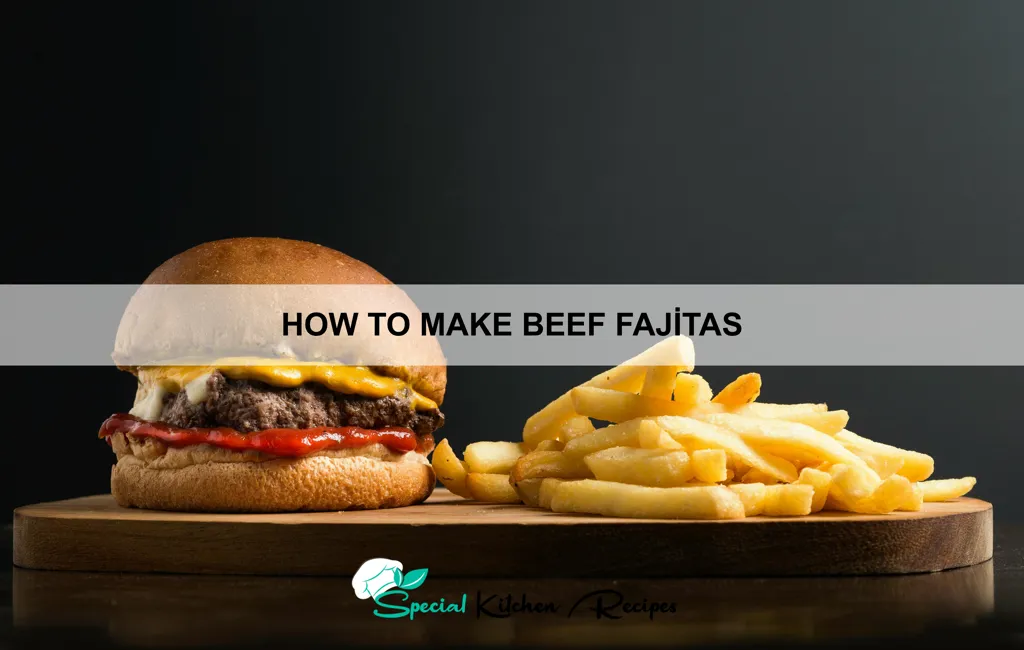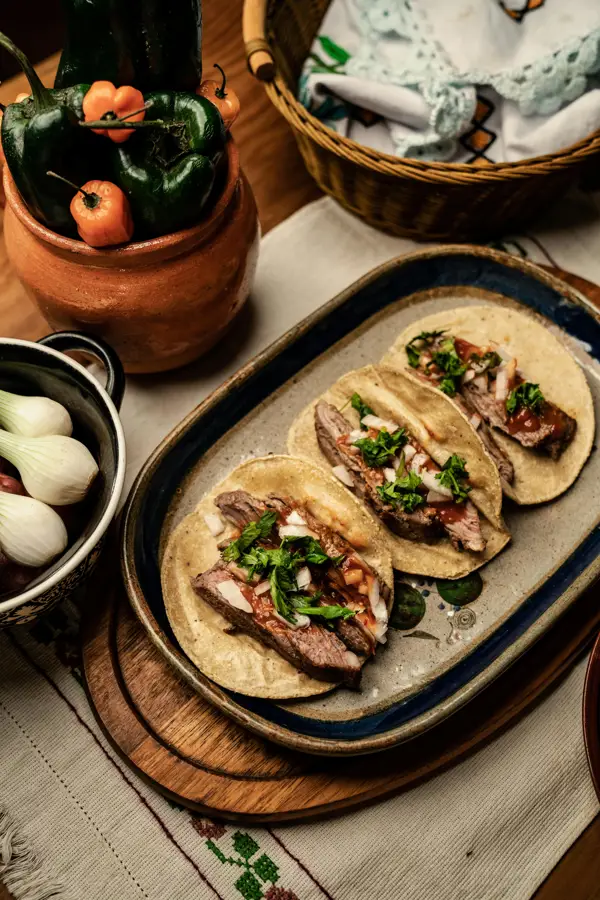Prepare to embark on a culinary journey to the heart of Tex-Mex cuisine with our guide on how to make delicious beef fajitas! This sizzling dish, a staple of Southwestern American cooking, boasts a surprisingly rich and fascinating history. While its exact origins are debated, the most widely accepted narrative traces fajitas back to the Mexican vaqueros (cowboys) of northern Mexico. These hardworking ranchers, often working vast distances from home, utilized readily available ingredients – namely, strips of beef – to create a hearty and simple meal. The term fajita itself is believed to derive from the Spanish word faja, meaning belt or strip, a direct reference to the long, thin cuts of meat used in the dish.
The transformation of fajitas from a humble rancher’s meal to a global phenomenon is a testament to its inherent deliciousness and adaptability. Its popularity exploded in the United States during the late 20th century, initially gaining traction in Texas before spreading across the country. Today, it’s estimated that billions of fajitas are consumed annually in the US alone, a testament to its broad appeal. The dish’s versatility shines through its endless variations: from the classic marinated skirt steak to chicken, shrimp, or even vegetarian options, the possibilities are virtually limitless. Furthermore, the vibrant array of toppings – onions, peppers, cilantro, guacamole, sour cream – allows for a personalized culinary experience each and every time.
Beyond its widespread popularity, fajitas hold a significant place in Mexican-American culture. It represents a fusion of traditions, blending the rustic simplicity of Mexican ranching culture with the innovative spirit of American cuisine. The communal nature of sharing fajitas, often cooked and assembled at the table, fosters a sense of togetherness and celebration. The sizzling sound of the meat hitting the hot skillet, the vibrant colors of the peppers, and the aroma of spices all contribute to a rich sensory experience that makes fajitas more than just a meal; it’s a cultural touchstone, a delicious representation of shared heritage and culinary creativity. In this recipe, we will explore the essential techniques for creating authentic, flavorful beef fajitas that will transport you straight to the heart of Tex-Mex tradition.
Ingredients and Measurements
This recipe yields approximately 6 servings of delicious beef fajitas. Accurate measurements are crucial for achieving the perfect balance of flavors and textures. We recommend using a kitchen scale for the most precise results, especially when measuring the beef.
Beef: 1.5 lbs (680g) of sirloin steak, thinly sliced against the grain. Choosing the right cut is paramount. Sirloin offers a good balance of tenderness and flavor, but you can also use flank steak or skirt steak, keeping in mind that these cuts may require slightly longer marinating times due to their tougher texture. Ensure the beef is sliced thinly (about 1/8 inch thick) for even cooking and optimal tenderness. If your butcher doesn’t slice it thinly, ask them to do it for you; it will save you time and effort.
Marinade: The marinade deeply infuses the beef with flavor. For this recipe, we’ll use:
- 1/4 cup (60ml) lime juice (freshly squeezed is best)
- 1/4 cup (60ml) olive oil
- 2 tablespoons (30ml) chili powder
- 1 tablespoon (15ml) ground cumin
- 1 teaspoon (5ml) garlic powder
- 1 teaspoon (5ml) onion powder
- 1/2 teaspoon (2.5ml) smoked paprika
- 1/4 teaspoon (1.25ml) cayenne pepper (optional, for extra heat)
- 1/2 teaspoon (2.5ml) salt
- 1/4 teaspoon (1.25ml) black pepper
Adjust the spices to your preference. If you prefer a milder fajita, reduce the amount of cayenne pepper or omit it altogether. For a spicier kick, add more cayenne or a pinch of chipotle powder.
Vegetables: Use a vibrant mix of bell peppers and onions for a colorful and flavorful dish.
- 1 large red bell pepper, thinly sliced
- 1 large green bell pepper, thinly sliced
- 1 large yellow bell pepper, thinly sliced
- 1 large onion, thinly sliced
Consider using a mandoline slicer for uniformly thin slices of both peppers and onions, ensuring even cooking.
Other Ingredients:
- Flour or corn tortillas (as many as needed)
- Your favorite toppings: shredded cheese, sour cream, guacamole, salsa, pico de gallo etc.
Remember to adjust the quantity of tortillas and toppings based on the number of servings. Have fun experimenting with different toppings to create your perfect fajita experience!
Equipment and Utensils
Making delicious beef fajitas requires the right tools to ensure even cooking and easy assembly. Here’s a breakdown of the essential equipment and utensils you’ll need:
Large Skillet or Cast Iron Pan (12-inch or larger): This is crucial for achieving that perfect sear on your beef strips. A large surface area allows for even cooking without overcrowding the pan, preventing steaming instead of searing. Cast iron is particularly recommended as it retains heat exceptionally well, contributing to a superior crust. If using a non-stick pan, avoid using metal utensils to prevent scratching.
Cutting Board (Large): You’ll need a spacious cutting board to comfortably chop your vegetables and slice the beef. Choose a sturdy, non-porous material like plastic or wood (properly sanitized) to prevent bacterial growth and ensure safe food preparation.
Sharp Chef’s Knife (8-inch): A sharp knife is essential for efficient and safe food preparation. Using a dull knife is more dangerous and leads to uneven cuts. Invest in a high-quality chef’s knife and keep it properly sharpened.
Measuring Cups and Spoons: Accurate measurements are vital for achieving the desired flavor balance in your marinade and ensuring the proper seasoning of your fajitas. Use standard measuring cups and spoons to ensure consistency in your recipe.
Mixing Bowls (at least two, medium-sized): You’ll need one bowl for marinating the beef and another for tossing the sliced vegetables. Glass or stainless steel bowls are ideal for marinating as they don’t react with the marinade ingredients.
Tongs: Tongs are invaluable for flipping the beef strips and vegetables in the skillet without piercing them and releasing their juices. Use heat-resistant tongs to prevent burns.
Wooden or Silicone Spatula: A spatula is helpful for scraping up any browned bits from the bottom of the pan to add flavor to your fajitas. Avoid metal spatulas in non-stick pans.
Serving Platter or Large Dish: You’ll need a large platter or dish to serve the cooked fajitas. A warm platter is preferable to keep the fajitas warm while you assemble the wraps.
Warming Tray (Optional): If you’re cooking for a large group, a warming tray can help keep the cooked fajitas warm while you prepare the rest of the meal.
Tortillas: You will need enough tortillas for your guests. Warm them gently on a griddle or in a dry skillet before assembling to make them more pliable.
Meat Preparation (Marinating and Slicing)
The success of your beef fajitas hinges heavily on the preparation of the meat. Proper marinating tenderizes the beef, infuses it with flavor, and ensures a juicy, delicious final product. We’ll be using about 1.5 lbs of thinly sliced sirloin steak, but you can substitute flank steak or skirt steak if preferred. Remember to choose a cut that’s naturally tender or one that benefits from marinating.
First, prepare your marinade. For a classic citrusy marinade, combine ½ cup lime juice, ¼ cup orange juice, 2 tablespoons olive oil, 1 tablespoon chili powder, 1 teaspoon cumin, 1 teaspoon garlic powder, ½ teaspoon onion powder, ½ teaspoon paprika, ½ teaspoon salt, and ¼ teaspoon black pepper in a medium bowl. Adjust the spices to your preference; feel free to add a pinch of cayenne pepper for extra heat.
Once your marinade is mixed thoroughly, add the 1.5 lbs of beef sirloin. Ensure the beef is fully coated by gently tossing it in the marinade. It’s crucial to use a non-reactive bowl, such as glass or stainless steel, to avoid any metallic taste affecting the marinade. Cover the bowl with plastic wrap and refrigerate for at least 30 minutes, or preferably 2-4 hours for optimal flavor penetration and tenderness. For even more tender meat, marinate overnight.
After marinating, remove the beef from the refrigerator and allow it to come to room temperature for about 15-20 minutes. This helps ensure even cooking. Now, it’s time to slice the meat. The key to perfect fajitas is thinly sliced beef. Use a very sharp knife and slice the beef against the grain in thin strips, approximately 1/8 inch thick. Slicing against the grain shortens the muscle fibers resulting in a much more tender bite. If you struggle with slicing thinly, you can partially freeze the beef for about 30 minutes before slicing; this will make it much easier to achieve consistently thin slices.
Once sliced, you can set the beef aside until you’re ready to cook. Avoid overcrowding the pan when cooking; work in batches to ensure even browning and cooking. Properly marinated and sliced beef is the foundation of fantastic fajitas, so take your time and follow these steps for the best results.
Vegetable Preparation (Cleaning and Slicing)
The success of your beef fajitas hinges significantly on the quality of your vegetable preparation. Perfectly sliced, vibrant vegetables contribute immensely to both the flavor and visual appeal of the dish. For this recipe, we’ll be using bell peppers and onions, but feel free to add other favorites like zucchini or mushrooms.
Begin with 2 large bell peppers (one red and one green for optimal color and flavor) and 2 large yellow onions. Choose firm, brightly colored peppers without bruises or soft spots. Similarly, select onions that are firm and free from blemishes. Thorough cleaning is paramount. Rinse the peppers and onions under cold running water, scrubbing gently to remove any dirt or residue.
Next, prepare the peppers for slicing. Remove the stems and the cores containing the seeds and membranes. This is crucial as the membranes can be slightly bitter. Once cleaned, cut each pepper in half lengthwise. Then, holding the pepper half firmly, slice it into thin strips, approximately 1/4 inch wide. Aim for consistent thickness to ensure even cooking. Discard any overly thick or uneven pieces.
Now, let’s turn our attention to the onions. Cut the onions in half lengthwise, then peel away the outer layers. If you find the onion’s aroma overpowering, briefly soak the cut halves in cold water for about 5 minutes. This helps to mitigate some of the strong smell. After soaking (optional), slice each onion half into thin strips, similar in width to the pepper strips – about 1/4 inch. Consistency in slicing is key for even cooking and a pleasing texture.
Once both the peppers and onions are sliced, place them in separate bowls. This prevents them from mixing and makes it easier to manage during the cooking process. Avoid slicing the vegetables too far in advance, as they can lose some of their crispness and vibrancy. Preparing them immediately before cooking is recommended for the best results. To summarize, you should have approximately 3 cups of sliced bell peppers and 2 cups of sliced onions. This quantity is ideal for a standard 4-6 serving recipe.
Professional Tip: For a quicker and more efficient slicing process, consider using a mandoline slicer (with the appropriate safety guard). This tool will ensure uniformly thin slices, saving you time and effort.
Cooking the Beef (Achieving Desired Doneness)
Once your beef strips are prepped (thinly sliced against the grain, about 1/4 inch thick and approximately 2-3 inches long), it’s time to cook them to perfection. The key to great fajitas is achieving your desired doneness without overcooking the meat, resulting in tough, dry strips. We’ll be focusing on achieving a delicious medium-rare to medium doneness, but you can adjust cooking times depending on your preference.
For this recipe, we’ll assume you’re using approximately 1.5 lbs of thinly sliced sirloin or flank steak. Heat a large cast iron skillet or heavy-bottomed pan over medium-high heat. Add 2 tablespoons of vegetable oil (or your preferred high-heat oil like avocado oil) to the hot pan. Allow the oil to shimmer before adding the beef. Do not overcrowd the pan; work in batches if necessary to ensure even browning.
Season generously with salt and pepper before adding to the hot pan. About 1 teaspoon of salt and 1/2 teaspoon of black pepper per pound of beef is a good starting point, but adjust to your taste. Sear the beef for 2-3 minutes per side, until nicely browned. This step is crucial for developing flavor and a good crust.
Once seared, reduce the heat to medium. Continue to cook the beef, stirring occasionally, until it reaches your desired doneness. Use a meat thermometer for the most accurate results. Here’s a guide:
- Rare: 125°F (52°C)
- Medium-Rare: 130-135°F (54-57°C) – This is ideal for fajitas as it results in tender, flavorful beef.
- Medium: 140-145°F (60-63°C)
- Medium-Well: 150-155°F (66-68°C)
- Well-Done: 160°F (71°C) – Avoid this for fajitas as the beef will be tough.
Once cooked, remove the beef from the pan and let it rest for 5-10 minutes before slicing it against the grain again, if needed, for extra tenderness. This allows the juices to redistribute, resulting in a more flavorful and juicy final product. Do not add the peppers and onions until the beef is almost completely cooked to prevent them from becoming mushy.
Remember, the cooking time will vary depending on the thickness of your beef slices and the heat of your stovetop. Always use a meat thermometer for the most accurate results and to avoid overcooking. Enjoy your perfectly cooked fajitas!
Cooking the Vegetables (Preserving Crispness)
The key to fantastic fajitas is perfectly cooked, crisp-tender vegetables. Overcooked vegetables become mushy and detract from the overall enjoyment of the dish. To achieve that perfect balance, we’ll use a quick-cooking method focused on high heat and short cooking times. For this recipe, we’ll use 1 large bell pepper (any color, or a mix!), 1 medium red onion, and 1 cup of sliced mushrooms. Feel free to add other vegetables like zucchini or asparagus, but keep in mind their cooking times might differ.
First, prepare your vegetables. Wash and thoroughly dry all ingredients. This is crucial for even cooking and preventing steaming. Properly drying your vegetables is key to achieving that delicious crispness. Cut the bell pepper into thin strips, approximately 1/4 inch wide. Slice the red onion similarly, aiming for thin, even slices. If using mushrooms, slice them to a consistent thickness. Having uniformly sized pieces ensures even cooking.
Heat 1 tablespoon of vegetable oil (or your preferred high-heat oil like canola or avocado oil) in a large skillet or wok over medium-high heat. High heat is essential for searing the vegetables and keeping them crisp. Once the oil is shimmering, add the bell peppers and onions to the pan. Don’t overcrowd the pan; work in batches if necessary to ensure even cooking and browning. Stir-fry for 3-4 minutes, stirring frequently to prevent burning.
After 3-4 minutes, add the mushrooms (if using) to the pan. Continue to stir-fry for another 2-3 minutes, or until the vegetables are tender-crisp. Avoid overcooking! The vegetables should still have a slight bite to them. You’ll know they’re ready when they’re bright in color and have slight char marks. Season immediately with 1/2 teaspoon of salt and 1/4 teaspoon of black pepper. Taste and adjust seasoning as needed. Remember that the beef will also add flavor, so don’t over-season at this stage.
Once cooked, remove the vegetables from the pan and set aside. Avoid leaving them in the hot pan, as residual heat will continue to cook them. You can optionally transfer them to a plate lined with paper towels to absorb any excess oil, but this step isn’t strictly necessary if you’ve avoided overcrowding the pan and used a moderate amount of oil.
Your perfectly crisp-tender vegetables are now ready to be combined with your sizzling beef and warm tortillas for the ultimate fajita experience!
Recommendations
For the best beef fajitas, ensure your beef is thinly sliced against the grain for maximum tenderness. Marinating the beef for at least 30 minutes, or preferably overnight, will enhance the flavor significantly. Don’t overcrowd the pan when cooking the beef; work in batches to ensure even browning and cooking. Properly sear the beef to achieve a delicious crust before adding the peppers and onions.
Once cooked, serve your fajitas immediately for optimal flavor and texture. Warm the tortillas according to package instructions – either on a griddle, in a microwave, or dry skillet – to prevent them from cracking. Fill the tortillas generously with the sizzling beef and vegetable mixture. For a truly authentic experience, consider adding toppings such as shredded cheese (Monterey Jack or Cheddar), sour cream, guacamole, salsa, pico de gallo, and chopped cilantro.
Leftover fajitas can be stored in an airtight container in the refrigerator for up to 3 days. Reheat gently in a skillet or microwave, avoiding overcooking which can dry out the meat. To prevent the tortillas from becoming soggy, it’s best to reheat them separately.
Serving Suggestions: Beef fajitas pair perfectly with Mexican rice, refried beans, Mexican street corn (Elote), or a simple side salad with a lime vinaigrette. Consider serving alongside margaritas or a crisp Mexican beer for a complete dining experience.
Nutritional Information (per serving, approximate): The nutritional content will vary greatly depending on the cut of beef, the quantity of vegetables used, and the amount of added toppings. However, a typical serving might contain approximately 350-500 calories, 25-40g of protein, 15-25g of fat, and 10-20g of carbohydrates. This is an estimate and should be adjusted based on your specific recipe and ingredients. For accurate nutritional information, use a nutrition calculator with your exact ingredients and quantities.
Important Note: Always ensure your beef is cooked to a safe internal temperature of 160°F (71°C) to prevent foodborne illness. Adjust cooking times as needed depending on the thickness of your beef slices and the desired level of doneness.





